Course:FNH200/Projects/2021/Chinese Liquor (Baijiu)
Introduction

In this research project, our team chose to focus on an alcoholic drink called Baijiu, which originated in China. Baijiu, along with brandy, gin, rum, vodka, and whiskey, is a sort of Chinese traditional distilled liquor that is regarded as one of the most famous distilled liquors in the world.[2] Baijiu is derived from the words, bai (transparent) and jiu (alcoholic drink). It is also known as Samshu, Baigan, or Shaojiu. The liquor is obtained by complex fermentation processes which utilize mixed culture starters followed by distillation. Fermentation techniques have been a part of Chinese tradition for centuries. Additionally, Baijiu is considered the backbone of Chinese fermented products, as approximately 12 million metric tons are produced annually.
History of Baijiu
Initially, millet was the primary grain used to create alcohol, or "yellow wine," but rice grew more popular. Distilled beverages did not gain popularity until the nineteenth century. Chinese alcohol has a warm aroma and a sweet flavor with no harshness after fermentation. Chinese distilled liquors are traditionally enjoyed with meals rather than had alone. Because alcohol was considered a sacred liquid in ancient China, it was only used to make offerings to Heaven, the Earth, or ancestors. Alcohol was recognized as one of the Nine Rites after the Zhou dynasty, and each dynasty placed a strong focus on alcohol management, creating separate ministries to oversee alcohol manufacturing and banqueting.[3] Yellow liquors (Huangjiu) and clear (white) liquors are the two most common varieties of Chinese liquor (Baijiu). Baijiu is frequently mistranslated as "wine" or "white wine," although it is a distilled liquor with an alcohol content of 40-60 percent by volume. It's commonly served on the tables of families and restaurants for get-togethers, celebrations, or just for fun and leisure.
Processing
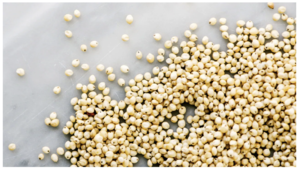
1. Preparing the ingredients of Chinese liquor (Baijiu)
Baijiu can be made from any grain. The most common ingredient to make Baijiu is sorghum. Different kinds of ingredients lead to different types of Baijiu. The ingredients vary from rice, sorghum to possibly a handful of other vegetables, grains, and even beans.[5] There are four main types of Baijiu, strong-aroma, light-aroma, sauce-aroma, and rice-aroma.[6] Strong-aroma Baijiu, also called ‘traditional Baijiu’, is produced from either simple grain that just contains one core ingredient or mixed grains. Light-aroma Baijiu is made from sorghum. Sauce-aroma Baijiu is created from sorghum, herbs, and beans. Rice-aroma Baijiu, as the name suggests, is made from long grain rice and herbs.
2. Steaming
Steaming gelatinizes the grains and breaks down their cellular wall, Allowing the later on the reaction that is associated with Qu.
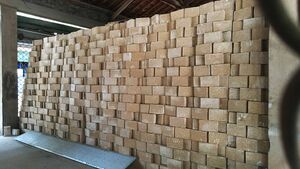

3. Preparing Qu
Qu also referred to as Jiuqu, is a pivotal component to the production of Baijiu. It serves two core purposes: saccharification and fermentation.[9] Also, Qu often gives Baijiu its unique aroma and taste. There are two types of Qu, Daqu (known as big Qu) and Xiaqu (small Qu). Different types of Baijiu use different types of Qu. For example, strong-aroma Baijiu uses Daqu. Rice-aroma Baijiu uses Xiaoqu. Daqu is made from wheat or cereal grains. Some manufacturers will also add vegetables to the Daqu to create a special flavor.[10] Xiaoqu, instead, is made from rice. Xiaoqu shapes like a small egg. Daqu is shaped like a big brick. That is why we call them Xiaou and Daqu respectively. Both Daqu and Xiaoqu require a complex process to be made. Finally, they will be ground down into powder to be added to the raw ingredients.
4. Saccharification
Powdered Qu and water are added to the ingredients. They are mixed together to allow more microorganisms to merge. The starches in the ingredients are then degraded by microorganisms to simple sugar.[9]
5. Fermentation
The ingredients of Baijiu, which are Qu and water are placed in a ceramic pot and left to ferment for several days or weeks. Different manufacturers have different places to put the ceramic pots in. Some like to bury the pots underground. Some build cellars to store the pots.[9] During fermentation, some manufacturers will just let the mixture ferment naturally, others will check the fermentation periodically and add more grain and Qu. Different production practices methods create different flavors of Baijiu.
6. Distillation
When the Baijiu mixture is ready to be distilled, it is poured into a still. The Baijiu mixture is heated through steam.[11] The alcohol produced by the fermented Baijiu mixture becomes vapor by the heat and then is separated from the mixture and collected by a device called the distillate. Usually, the first and last portion of distillate will be discarded since it contains a high level of toxin.[9]
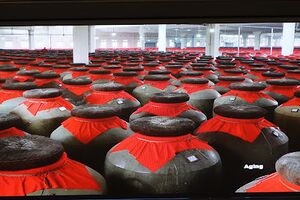
7. Aging
The main purpose of aging is to alter the chemical composition of Baijiu distillate. The immature Baijiu contains high levels of aldehydes, which will irritate the esophagus and make for an unpleasant sip. By letting the distillate sit for a period, the oxygen in the surrounding environment will interact with aldehydes and thus break down aldehydes, giving the beverage a mellower flavor.[9] Six months is the minimum period that a Baijiu should be left to age, or Baijiu will be too harsh for the human throat to accept.[11] While Baijiu is left to age, it will be put into highly porous clay pots that can help Baijiu better interact with the environment. Then the clay pots will be stored in musty cellars or natural caverns where the cool, dank air limits the evaporation of Baijiu.
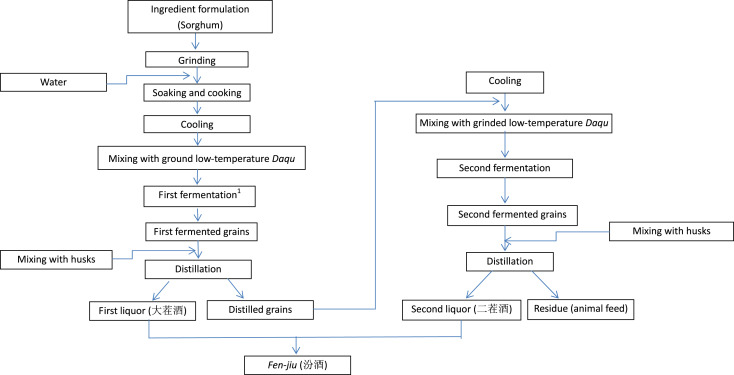
Types of fermentation
SSF Baijiu (solid-state fermentation)
Solid-state fermentation is one of the most commonly used fermented methods in Baijiu manufacturing industries. It has a long history, passed on through several generations. During this process, microbial cultures are grown on a solid matrix in the absence of a liquid or aqueous phase. Solid-state fermentation used grains, such as sorghum, wheat, rice, glutinous rice, and maize. These ingredients go through the process of material preparation, Qu making, solid-state fermentation, solid-state distillation, and aging. The products will contain around 60 percent water. Because different fermentation processes and operation conditions will lead to different flavors of Baijiu, Solid-state fermentation is considered as the method that can produce maximal types of Baijiu.[2]
Semi-SSF Baijiu (semi-solid-state fermentation)
The semi-solid-state method is similar to the solid-state fermentation method, which is commonly used in Baijiu industries. Instead of a solid matrix, microbial cultures are grown in a semi-solid state. Guilinsanhua-jiu and Quanzhouxiangshan-jiu are typical semi-solid-state Baijiu.[2]
Liquid-state fermented Baijiu
Different from the other two methods, this method is based on liquid-state fermentation. All the production processes are saccharification, fermentation, and distillation performed under a liquid state. Hongxingerguotou-jiu is liquid-state fermented Baijiu.[2]
Factors that influence fermentation
Raw materials
Raw materials are important factors that influence the productivity and quality of fermented food, because they provide nutrition for microbial growth, and influence microbial metabolism, which could hence the fermentation process. First of all, grain choices play an important role in food fermentation and final food quality, with an example of glutinous and non-glutinous sorghums, which are classified based on starch composition. Different cereal cultivars will lead to different types of Baijiu products, with two famous types, Maotai-flavor and Fen-flavor. Maotai-flavor liquor is produced by glutinous sorghum, while Fen-flavor liquor is produced by non-glutinous sorghum. Because they choose different grains, they have different fermentation processes as well as different flavor characteristics.[13]
Fun fact: In the manufacture of Baijiu, Daqu is used as the traditional fermentation starter. On the other hand, Daqu itself is also made by 1-month solid-state fermentation, followed by a 6-months storage period for maturation. Successful products will be used in liquor manufacture and the unsuccessful products will be used as animal feed.[2]

Environmental conditions
Initial environmental conditions play a vital role in the succession of liquor fermentation. In the beginning stage of fermentation, all environmental conditions are controlled, including moisture, pH, oxygen, and temperature. Nowadays, in the manufacturing industries of Baijiu, a predictable model is used to connect environmental factors with liquor quality and productivity, to control the flavor compounds. [14]
Storage
The storage of Qu is crucial for microbial communities to grow. Within the Qu, a mixture of bacteria, fungi, and yeast are often stored at a warm temperature for a month before being put into the grains for saccharification and fermentation.[7] During aging, Baijiu will be placed in a dark and preferable underground environment for more than 1 year to develop more flavor and aroma.
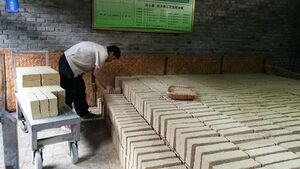
For finished products, if this certain type of Baijiu contains 50% or higher alcohol by volume (ABV),[15] there will be more requirements for storage since the alcohols in Baijiu tends to volatilize and leads to some changes in the volatiles. Commonly, Baijiu does not have a shelf life and aging will enhance its flavor and aroma; however, improper long-time storage will still affect its quality. It is best to wrap the high ABV Baijiu in well-sealed packaging to prevent a bitter taste from volatilization.
Aroma & Flavor of Baijiu
The classification of Baijiu is named by its aroma, and there are 12 types of Baijiu with its unique taste and flavor[16]. Both the types of bacterial starter cultures (Qu) and different techniques of making Baijiu contribute to its aroma. Aging is also an important part for Baijiu to develop its flavor, during which more chemical reactions will be triggered by microorganisms.
Microbial Communities

Qu contains a mixture of bacteria, fungi, and yeast, and they all coexist during Baijiu’s fermentation while they occupy the grains. Its microbial diversity produces Baijiu’s strong flavor during fermentation.[17] Factors like weather and geographical location can also influence the growth of those microbial communities. Besides microorganisms within Qu and the fermented grains, those who live among Baijiu’s aging environment will also affect its production.
Aging
Aging is a fundamental step of manufacturing Baijiu, which is directly related to Baijiu’s price. The quality of Baijiu is often associated with how long it has been aged. Chemical reactions like the Maillard reaction and physical molecular movements will take place during the process of aging, which increases its flavor more.[2] Different aroma components are found in different aged Baijiu. Volatiles within Baijiu contain chemicals like acids and alcohols that create aroma differences between well-aged Baijiu and fresh ones. Although some volatiles will volatilize overtime during aging, some aroma components show a significant increase over time.[18] This finding explains why the longer the Baijiu has been aged, the stronger the flavor it gets. Since a part of alcohol that does not contain strong aroma properties volatilizes over time, the concentration of those that contribute to aroma and flavor will increase. As aging is an essential step of manufacturing Baijiu, it contributes to its strong aroma and flavor that differentiate various types of Baijiu. For example, strong and light aroma Baijiu should be aged over a year while sauce aroma Baijiu will be aged for more than 3 years.[2]
Industrial challenges
Because of the lack of control and standardization, there are many drawbacks to traditional fermentation in the Baijiu industry. Nowadays, the traditional process of Baijiu is facing industrial challenges and it is necessary to develop.
Risks in quality and safety
During the storage of fresh Baijiu, some toxins may be formed that will affect food safety, such as ethyl carbamate, which is genotoxic and carcinogenic. Also, the open and spontaneous fermentation of Baijiu may lead to contamination of microbial toxins. As a result, liquor manufacturers need to optimize storage conditions and storage methods. What is more, many alcoholic drinks contain higher alcohols like isobutanol and isoamyl to contribute to the flavor and taste of Baijiu, however, they are potential health hazards in excess amount. As a result, it is important to control the content of higher alcohol in an appropriate range.[19]
Environment issues
Nowadays, the Baijiu industry still uses a traditional and primitive process, so fermentation, distillation, and blending processes are poorly controlled. There is still a long way to recognizing the urgency of cleaner production, efficient water use, and energy recycling but substantial change is still to be realized.[19]
Exam Question
Which group of microorganisms are the dominant group during Baijiu’s fermentation?
A. Psychrophiles
B. Psychrotrophs
C. Mesophiles
D. Thermophiles
Answer: D
In lesson 5.4, we learn about different temperature requirements for a certain type of microorganism to grow. Thermophiles are those that are tolerant of high temperatures (50 to >100°C). During Baijiu’s fermentation, both Qu and the raw materials of the Baijiu will go through high temperatures for better fermentation. This fact indicates that the starter cultures in Qu are thermophiles since they can grow well in high temperatures.
References
- ↑ "Top of the line Baijiu to Drive Chinese Alcohol Market Growth?". SEO China Agency. March 5, 2020.
- ↑ 2.0 2.1 2.2 2.3 2.4 2.5 2.6 2.7 Zeng, X. & Han, B. (March, 2016). "Baijiu (白酒), Chinese liquor: History, classification and manufacture". Journal of Ethnic Foods. 3: 19–25 – via Science Direct. Check date values in:
|date=(help)CS1 maint: multiple names: authors list (link) - ↑ "Chinese Alcohol, Chinese Spirits". China Daily. October 27, 2010.
- ↑ Davidson, Katey (November 26, 2019). "What Is Sorghum? A Unique Grain Reviewed". Healthline.
- ↑ "Ingredients". Drink Baijiu.
- ↑ "Baijiu Aromas: All The Different Types Of Baijiu". Baijiu Brands.
- ↑ 7.0 7.1 7.2 "The spirit of China forever". Spirits Selection.
- ↑ "Baijiu basics: How big is your qu?". December 19, 2011.
|first=missing|last=(help) - ↑ 9.0 9.1 9.2 9.3 9.4 "How To Make Baijiu: The 7 Steps". Love Baijiu.
- ↑ "Baijiu Ingredients". Love Baijiu.
- ↑ 11.0 11.1 "How to Make Baijiu". Drink Baijiu.
- ↑ Sandhaus, Derek (June 14, 2019). "Historical Tidbits About Baijiu, The World's Most Popular Spirit".
- ↑ Wu, Q., Cao, S. & Xu, Y. (April 27, 2017). "Effects of glutinous and nonglutinous sorghums on Saccharomyces cerevisiae fermentation for Chinese liquor making". International Journal of Food Science & Technology. 52: 1348–1357 – via Wiley.CS1 maint: multiple names: authors list (link)
- ↑ 14.0 14.1 Wu, Q., Zhu, Y., Fang, C., Wijffels, R. H., & Xu, Y. (April, 2021). "Can we control microbiota in spontaneous food fermentation? – Chinese liquor as a case example". Trends in Food Science & Technology. 110: 321–331 – via Science Direct. Check date values in:
|date=(help)CS1 maint: multiple names: authors list (link) - ↑ Chan, May (February 4, 2020). "Baijiu Storage Tips From An Expert Baijiu Collector". Baijiu Blog.
- ↑ Xu, Y., Sun, B., Fan, G., Teng, C., Xiong, K., Zhu, Y., Li, J., & Li, X. (March 24, 2017). "The brewing process and microbial diversity of strong flavour Chinese spirits: a review". Journal of the Institute of Brewing. 123: 5–12 – via Wiley.CS1 maint: multiple names: authors list (link)
- ↑ 17.0 17.1 Hai, N & Yuan, L (November 29, 2013). "Characterization of Bacterial Community of "Hetao" Strong-Flavor Chinese Liquor Daqus by PCR–SSCP". Proceedings of the 2012 International Conference on Applied Biotechnology. 1: 507–512 – via Springer.CS1 maint: multiple names: authors list (link)
- ↑ Xu, M., Yu, Y., Ramaswamy, H. & Zhu, S. (January 6, 2017). "Characterization of Chinese liquor aroma components during aging process and liquor age discrimination using gas chromatography combined with multivariable statistics". Scientific Reports. 7 – via Nature.CS1 maint: multiple names: authors list (link)
- ↑ 19.0 19.1 Jin, G., Zhu, Y. & Xu, Y. (May, 2017). "Mystery behind Chinese liquor fermentation". Trends in Food Science & Technology. 63: 18–28 – via Science Direct. Check date values in:
|date=(help)CS1 maint: multiple names: authors list (link)